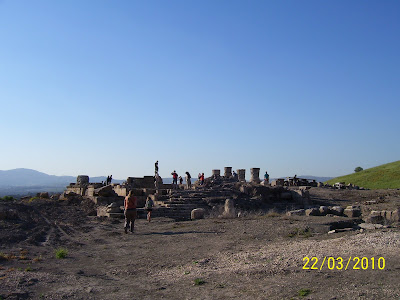



 We then went to the excavation site of Omrit. Located in the northeast corner of the Huleh Valley on the foot of the Golan Heights, the ancient site of Omrit sits atop a foothill of Mount Hermon. After a brushfire cleared the area and revealed some interesting hewn stone in 1998, archeologists from Macalester College of St. Paul, Minnesota began excavating. Thus far excavations have yielded three phases of Roman temple construction approximated at mid first century BC, 20BC and first century AD. It sits on the Roman road to Damascus and it is curious to ponder whether Saul of Tarsus had made it this far before his encouter with the Lord? We had a lot of fun crawling all over the site looking for treasures. I did find a small piece of marble which is interesting because it is not a stone native to the area and any marble had to be brought in from Greece or somewhere, but left it for the Macalester students. Nat gathered up some seeds of Israel's variety of our Texas bluebonnet . . . except much larger! Since the pods are still green, not sure if the seed will be viable but going to try them and see.
We then went to the excavation site of Omrit. Located in the northeast corner of the Huleh Valley on the foot of the Golan Heights, the ancient site of Omrit sits atop a foothill of Mount Hermon. After a brushfire cleared the area and revealed some interesting hewn stone in 1998, archeologists from Macalester College of St. Paul, Minnesota began excavating. Thus far excavations have yielded three phases of Roman temple construction approximated at mid first century BC, 20BC and first century AD. It sits on the Roman road to Damascus and it is curious to ponder whether Saul of Tarsus had made it this far before his encouter with the Lord? We had a lot of fun crawling all over the site looking for treasures. I did find a small piece of marble which is interesting because it is not a stone native to the area and any marble had to be brought in from Greece or somewhere, but left it for the Macalester students. Nat gathered up some seeds of Israel's variety of our Texas bluebonnet . . . except much larger! Since the pods are still green, not sure if the seed will be viable but going to try them and see. We drove past areas where battles took place in the 1967 "Six Day War" & the 1973 "Yom Kippur War". In both conflicts Israel won, pushing the border to Damascus and both times giving it back to Syria . . . mistake? Israel did keep areas atop the Golan Heights, primarily 2 extinct volcanoes which, allow excellent viewing and military vantages in regard to keeping an eye on any future military buildups. Plus, there is an additional buffer zone (DMZ) which is enforced by UN troops. During peace negotiations after '73 war, it is said Prime Minister Golda Meier gave Defense Minister Moshe Dayan strict instructions to "Keep the volcanoes." It was already dark when we arrived this site, but we'll be going again and take photos.
Another good night's rest, and we checked out of our rooms after breakfast on Tuesday. I made my way down to the water's edge, at least dipping my toe in the Sea of Galilee. I didn't test walking on the water. Nat never got in, but sure had fun saying, "I swam today where Jesus walked." Before leaving the area we went to Ein Gev Harbor, which is part of the kibbutz operation, and went out onto the Sea in one of their boats. We anchored in the middle of the Sea while Cyndi pointed out the physical settings around us as they relate to the Bible and places Jesus & his disciples would have been. Different political systems surrounded the Sea in that day. Locals would most likely cross the Sea by boat to avoid taxations on land, from one area to another.
On to Kursi, and the ruins of a Byzantine monastery. This is another site where tradition has Jesus healing the demon possessed. Cyndi used this opportunity to remind us that Matthew's gospel was written to the Jews, Mark wrote to the Romans, and Luke to the Greeks. Many times, depending on who Jesus was talking to as he traveled (even in regions surrounding the Sea of Galilee) He would caution the Jews, "Don't tell (what I have done for you) . . .", so as to not stir things up. Other times, He would say to the Romans, "Go tell . . .", because they weren't looking for a Messiah & Jesus then wanted to stimulate thought and discussion. I found this insightful. They not only grow huge "bluebonnets" in Israel, but take a look at the dandelion Nat is holding!

1 comment:
From the Gulf Clipper to a 'clipper' on the Sea of Galilee.....what a journey.
Post a Comment